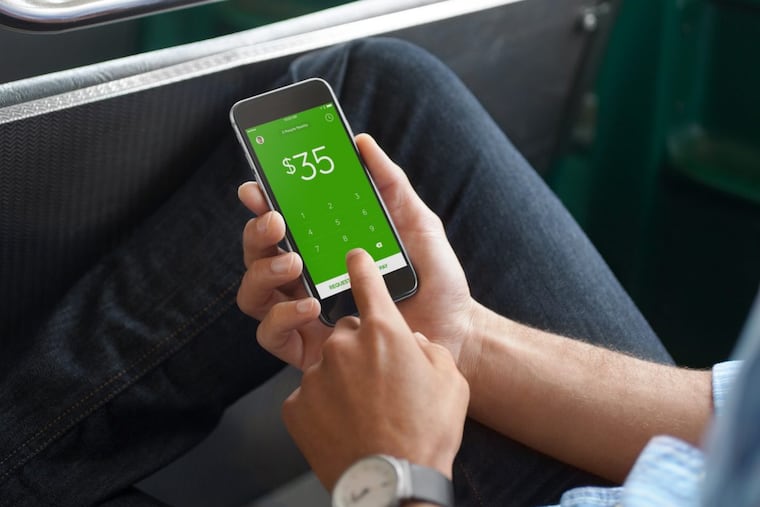Millennials, teens embrace payment apps, texting $$$ instead of cash
Teens and millennials use payment apps to send each other money. The most popular are Venmo, owned by PayPal; Cash App, owned by Square; and payment apps linked to Snapchat or the smartphone itself, such as ApplePay and SamsungPay.

Parents, grandparents, and other old heads like myself, it's time to learn about payment apps — how they function and what are the risks.
We asked Kasey Schram, a Rutgers-Camden business school student, to help us find out how teenagers and millennials pay each other and exchange money. News flash: They don't use cash.
Young people use payment apps — or applications on their smartphones — to pay each other. The most popular apps are Venmo, owned by PayPal; Cash App, owned by Square; and payment apps linked to Snapchat or the smartphone itself, such as ApplePay and SamsungPay. The applications let you link your bank accounts — a checking account or credit card — to pay someone, and payments aren't always cheap.
The big banks recently launched a competing app to play catch-up: it's called Zelle (you may have seen the ads on TV). But Schram and her millennial pals didn't know much about that because "quite frankly, I haven't met a single person that's used it."
She probably means a person under 30.
What do young reviewers say about these payment apps? Schram uses Venmo, and it's as easy as texting money to her friends. (You can see who and how much your friends are paying one another. Creepy — but, hey, they love it.)
Schram's adviser at Rutgers-Camden, assistant dean Kandace Diedrick, has used Venmo to pay contractors, but worries about how these funds are tracked. Another friend has a personal Cash App account and a business account, and accidentally sent money to her daughter from her business account side and had no idea until it was mentioned to her.
"Would this be a problem moving forward with integrating money transfer apps in business transactions?" Schram asked. It's a great question.
What about security risks and hacking? At least one Venmo account was compromised last year and the company does not — I repeat, does not — offer buyer or seller protection. Zelle users have also been scammed, according to consumers who were defrauded and interviewed by Tech Crunch. And app makers Venmo and Zelle insist these should only be used by "friends and family," as per the user agreement.
How are you supposed to know everyone with whom you transact?
"People either use these apps or they don't — which leads me to believe that most people don't know how these services are making money, they don't care where their money is going, or if they aren't using the services because they don't trust the security system," said Schram, who in addition to studying full-time, waitressing, and working as an intern at the CFA Society of Philadelphia is looking for a job in finance.
Now, to fees: Cash App personal payments are free; business payments cost 2.75 percent (paid by the recipient); standard deposits between one to three days are free, while instant deposits cost between 1 percent and 1.5 percent. It's a tidy profit for these payment app companies.
On Venmo, sending money via a bank account, debit card, or prepaid card is free. If you want to send money using a credit card, a whopping 3 percent fee applies.
While Venmo and Cash App aren't yet popular for payments on items such as cable, Netflix, food shopping, or electric bills, "many landlords and private contractors are accepting this type of payment arrangement," Schram added, particularly from students.
Zelle, owned by Early Warning Services, is a newcomer money-transfer app with a different take: Banks partner with Zelle and charge no additional fees. Zelle also offers instant payment instead of having to wait the one to three business days standard on some of the other apps.
We aren't recommending these apps — just want to give you the heads-up that they exist, and are growing like crazy. So, if your kids ask you to link their bank account (or yours) to an app, be aware of the uses and risks.
Tax cut in your paycheck?
Readers, we want to hear from you: Take a look at your paycheck and let us know — what kind of a raise did you get, if any? Are you happy with the outcome? Let us know.
Separately, the IRS released the new 2018 federal income tax withholding tables — and those adjustments should be reflected in upcoming payroll. The changes are not retroactive, and should be effective in your paycheck over the next few weeks.
The new tax tables are based on your specific W-4 form withholding status, and the number of exemptions you claim. If you wish to update your W-4 form, contact your payroll or human resources department.
"The benefit of updating your W-4 is that you may run the risk of withholding too much money, because the tax brackets are wider, so more people are falling into a different or lower bracket. So if you don't adjust your withholding for 2018, an employer will guess and they may withhold too much," said Tim Speiss, partner in charge of personal wealth advisers practice at EisnerAmper in New York.
To help small businesses apply recent law changes, the Treasury Department and the IRS issued Notice 2018-14 and Publication 15, Employer's Tax Guide. These are designed to help with questions during and after the transition to reduced tax rates and updated withholding tables. See this IRS website publication www.irs.gov/pub/irs-drop/n-18-14.pdf for help. The W-4 form itself is available at: www.irs.gov/pub/irs-pdf/fw4.pdf. It's not easy to navigate, but it's available.